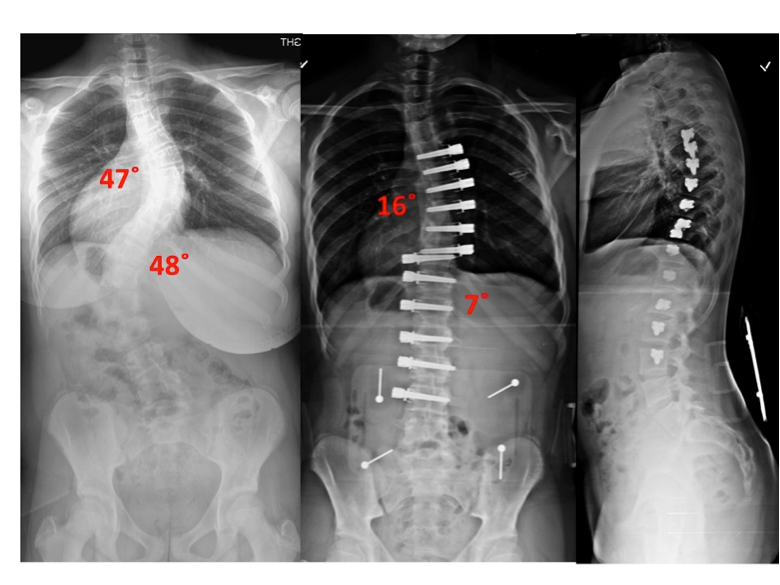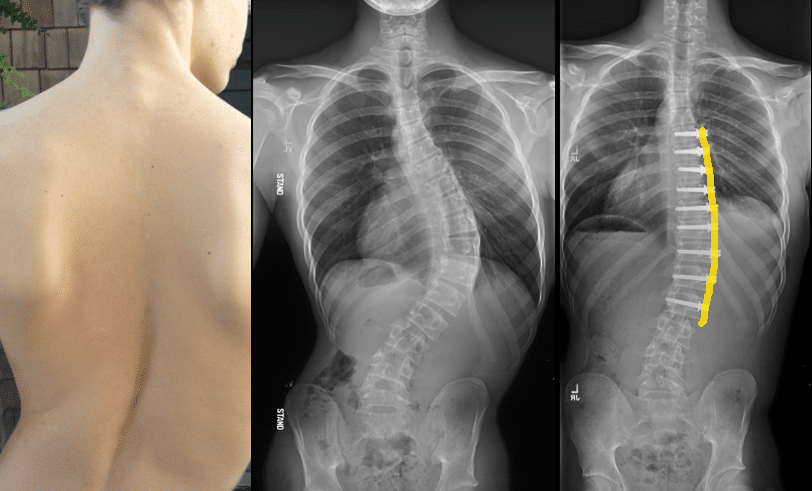Scoliosis is a condition characterized by an abnormal curvature of the spine, which can cause pain, discomfort, and limited mobility. Anterior Scoliosis Correction (ASC) is a surgical procedure that aims to correct the curvature of the spine from the front, offering several advantages over traditional posterior approaches. This article will explore the benefits of ASC Scoliosis Surgery, the recovery process, and the long-term outcomes associated with this treatment option.

Understanding Anterior Scoliosis Correction (ASC)
ASC Scoliosis Surgery involves accessing the spine through the front of the body, allowing the surgeon to directly visualize and correct the curvature. This approach offers several advantages over traditional posterior approaches, including improved cosmetic outcomes, reduced blood loss, and shorter hospital stays. By accessing the spine from the front, surgeons can more effectively correct the curvature and restore spinal alignment.
Advantages of ASC Scoliosis Surgery
One of the primary advantages of ASC Scoliosis Surgery is improved cosmetic outcomes. By accessing the spine from the front, surgeons can minimize visible scarring and preserve the natural contours of the back. This is particularly important for younger patients who may be self-conscious about their appearance.
Additionally, ASC Scoliosis Surgery has been shown to reduce blood loss during the procedure. By accessing the spine through the front, surgeons can avoid major blood vessels, resulting in less intraoperative bleeding. This can lead to a reduced need for blood transfusions and a faster recovery.
Another advantage of ASC Scoliosis Surgery is the shorter hospital stay associated with this procedure. Traditional posterior approaches often require a longer hospital stay due to the extensive muscle dissection and trauma. In contrast, ASC Scoliosis Surgery allows for a quicker recovery and earlier discharge from the hospital, leading to reduced healthcare costs and improved patient satisfaction.

Preparing for ASC Scoliosis Surgery
Before undergoing ASC Scoliosis Surgery, patients will undergo a thorough preoperative evaluation. This may include blood tests, imaging studies, and consultations with the surgical team. It is important for patients to disclose any preexisting medical conditions or medications they are taking to ensure a safe and successful surgery.
In addition, patients will be advised to stop smoking and avoid certain medications, such as blood thinners, in the weeks leading up to the surgery. This is to minimize the risk of complications during and after the procedure.
The Surgical Procedure of ASC Scoliosis Surgery
During ASC Scoliosis Surgery, the patient is placed under general anesthesia. The surgeon makes a small incision in the side of the chest or abdomen, depending on the location of the curvature. Through this incision, the surgeon accesses the spine and removes any abnormal bone or tissue causing the curvature. The spine is then realigned using rods, screws, or other instrumentation, and bone grafts may be used to promote fusion and stability.
The duration of the surgery varies depending on the severity of the curvature and the complexity of the procedure. On average, ASC Scoliosis Surgery can take anywhere from 4 to 8 hours.
Potential Risks and Complications of ASC Scoliosis Surgery
Like any surgical procedure, ASC Scoliosis Surgery carries certain risks and potential complications. These can include infection, bleeding, nerve damage, and failure of the fusion to occur. However, with advancements in surgical techniques and postoperative care, the risk of complications has significantly decreased.
It is important for patients to discuss these risks with their surgeon and understand the potential benefits and drawbacks of the procedure before making a decision.
Postoperative Care and Recovery Process
After ASC Scoliosis Surgery, patients are closely monitored in the recovery room before being transferred to a regular hospital room. Pain management is a crucial aspect of postoperative care, and patients are typically given pain medications to help manage discomfort.
Patients are encouraged to start moving and walking as soon as possible after surgery to prevent complications such as blood clots and muscle stiffness. Physical therapy is an integral part of the recovery process and helps patients regain strength, flexibility, and mobility.
Pain Management Strategies after ASC Scoliosis Surgery
Effective pain management is essential for a smooth recovery after ASC Scoliosis Surgery. This may involve a combination of medications, such as opioids and nonsteroidal anti-inflammatory drugs (NSAIDs), as well as non-pharmacological approaches like ice packs and heat therapy. The goal is to control pain while minimizing the use of opioids to reduce the risk of addiction and other side effects.
Rehabilitation and Physical Therapy for ASC Scoliosis Surgery Patients
Physical therapy plays a crucial role in the recovery process after ASC Scoliosis Surgery. A physical therapist will work closely with the patient to develop a personalized rehabilitation program that focuses on strengthening the core muscles, improving flexibility, and restoring normal movement patterns. This helps patients regain function and return to their daily activities.

Expected Outcomes and Long-Term Benefits of ASC Scoliosis Surgery
ASC Scoliosis Surgery has been shown to effectively correct spinal curvature and improve quality of life for patients. Studies have demonstrated significant improvements in pain, function, and overall satisfaction following the procedure. Additionally, the improved cosmetic outcomes associated with ASC Scoliosis Surgery can have a positive impact on a patient’s self-esteem and body image.
Follow-up Care and Monitoring after ASC Scoliosis Surgery
After ASC Scoliosis Surgery, patients will have regular follow-up appointments with their surgeon to monitor their progress and ensure proper healing. X-rays and other imaging studies may be performed to assess the fusion and alignment of the spine. Physical therapy may continue for several months to optimize recovery and prevent complications.
Conclusion: ASC Scoliosis Surgery as an Effective Treatment Option
ASC Scoliosis Surgery offers several advantages over traditional posterior approaches, including improved cosmetic outcomes, reduced blood loss, and shorter hospital stays. While there are risks and potential complications associated with the procedure, advancements in surgical techniques and postoperative care have significantly reduced these risks. With proper preparation, postoperative care, and rehabilitation, patients can expect significant improvements in pain, function, and overall quality of life. ASC Scoliosis Surgery is an effective treatment option for individuals with scoliosis, providing long-term benefits and improved spinal alignment.
Referências
- Lenke, L.G., Betz, R.R., Harms, J., et al. “Anterior spinal surgery in the treatment of adolescent idiopathic scoliosis.” Lombada (Phila Pa 1976). 1998;23(14):1583-1591. doi: 10.1097/00007632-199807150-00010.
- Negrini, S., Donzelli, S., Aulisa, A.G., et al. "Diretrizes SOSORT 2016: Tratamento ortopédico e de reabilitação da escoliose idiopática durante o crescimento." Escoliose e doenças da coluna vertebral. 2018;13:3. doi: 10.1186/s13013-018-0175-8.
- Newton, P.O., Faro, F.D., Gollogly, S., et al. “Results of anterior spinal fusion for adolescent idiopathic scoliosis in patients younger than 11 years of age.” Journal of Bone and Joint Surgery America. 2005;87(12):2641-2649. doi: 10.2106/JBJS.D.01952.
- Lonner, B.S., Auerbach, J.D., Estreicher, M.B., et al. “Surgical correction of adolescent idiopathic scoliosis with anterior instrumentation: Radiographic and clinical outcomes with a minimum 5-year follow-up.” Lombada (Phila Pa 1976). 2006;31(2):159-165. doi: 10.1097/01.brs.0000194767.60942.14.
- Hresko, M.T. "Prática clínica. Escoliose idiopática em adolescentes." Jornal de Medicina de Nova Inglaterra. 2013;368(9):834-841. doi: 10.1056/NEJMcp1209063.
- Kim, Y.J., Lenke, L.G., Kim, J., et al. “Thoracic anterior spinal fusion versus posterior spinal fusion: The effect on pulmonary function in adolescent idiopathic scoliosis.” Lombada (Phila Pa 1976). 2003;28(20):2229-2234. doi: 10.1097/01.BRS.0000090886.71010.74.
- Newton, P.O., Upasani, V.V., O’Brien, M.F., et al. “A prospective, randomized clinical trial comparing pedicle screw versus hook instrumentation in adolescent idiopathic scoliosis.” Lombada (Phila Pa 1976). 2008;33(20):2034-2041. doi: 10.1097/BRS.0b013e31817e8d60.
- Suk, S.I., Kim, J.H., Kim, S.S., et al. “Anterior-posterior surgery versus posterior-alone surgery in thoracic adolescent idiopathic scoliosis: 10-year follow-up.” Journal of Orthopaedic Science. 2006;11(5):420-426. doi: 10.1007/s00776-006-1047-y.
- Bettany-Saltikov, J., Weiss, H.R., Chockalingam, N., et al. "Intervenções cirúrgicas versus não cirúrgicas em pessoas com escoliose idiopática do adolescente". Base de dados Cochrane de revisões sistemáticas. 2015;2015(4). doi: 10.1002/14651858.CD010663.pub2.
- Berven, S., and Deviren, V. “Radiographic and clinical results of anterior scoliosis surgery in adolescents and adults: a literature review.” Clínicas Ortopédicas da América do Norte. 2007;38(4):515-521. doi: 10.1016/j.ocl.2007.07.003.

